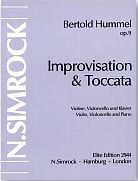Improvisation & Toccata for Violin, Violoncello and Piano, op. 9 (1954)

I.
Improvisation ![]() beginning
beginning
II. Toccata
First
Performance : June 21, 1955, Cape Town (S.A.), Hiddingh Hall
Inken Hummel-Steffen
/ Bertold Hummel / Virginia Fortescue
Duration: 12 Minutes
Publisher: N. Simrock Hamburg-London (Boosey & Hawkes) EE 2944 / ISMN M-2211-0846-3
| I. | II. |
Video: Works by Hummel on youtube
The Piano Trio, op. 9, from the year 1954, breaks the tradition of the classical-romantic piano trio inasmuch as it rejects the usual formal pattern and combines simply two movements of differing construction but with thematic material derived from one basic tone series. It is distinguished from a twelve-tone work of the Sch÷nberg school by a kind of cell technique, in which small particles are separated out from the complete twelve-tone series and used independently - particles which in their structure of thirds and seconds have a similarity to the BACH motif (German notation for B flat : A : C : B) but contain more combinations of thirds and reveal in the second movement their real origin: the fugue from the Symphony of Psalms by Stravinsky. By constant transformation of the intervals through octave transpositions and inversion, multifarious constellations appear, suitable for flexible formal construction. The opening movement with title "Improvisation" develops within its cyclical setting (in which the series is presented by the violoncello at the beginning and end of the movement) a rhapsody-like succession of arabesques. The second movement, "Toccata", departs from this filigree work and is striking in its use of mighty blocks of sound and strict linearity. Its form, marked particularly by the reprise in fifth transposition of its beginning, is a series of sections, each derived metamorphosis-like from the opening.
Bertold Hummel's Trio was written in 1954. In the first movement, Improvisation, a twelve-tone row is presented, but its further use is less a matter of the linear succession of the tones 1 - 12 than an exploitation of its potential for chromatic dissonance: a - b flat; d - c sharp; e - e flat; c - b; a flat - g flat - f - g, from which Hummel's bed of sound, notated in weightless 7/5 time, takes on a bitter-sweet sonority. The appropriate techniques required from each instrument, the use of particular positions and repetition effects all match the improvisatory character of the first movement. The second movement, Toccata, is in contrast characterised by a forceful treatment of material and creates, in 5/4 time, successions of powerful chord blocks in a somewhat static grouping method, reminiscent of the historical Toccata genre. The cell from which the opening and further ideas in the course of the movement are derived is taken from the fugue in Stravinsky's Symphony of Psalms.
Press
Der Tagesspiegel, Berlin 3rd December, 1955
In Bertold Hummel's more astringent Toccata, a highly individual power seems to be announcing its entrance